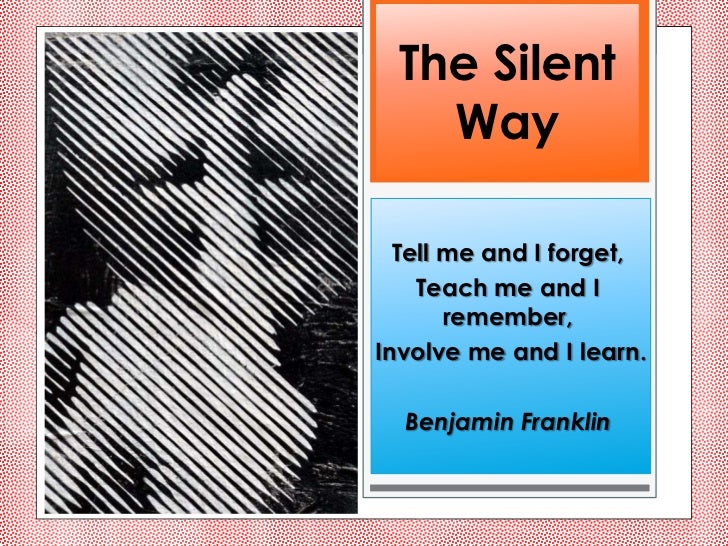The Beginning
The Silent Way, this unconventional method was developed in the 1970s by mathematician Caleb Gattegno. It was based upon ideas outlined in his book “Teaching Foreign Languages in Schools the Silent Way,” published in 1963. Like most things from the 60s and 70s, it was a reaction to previous approaches and methods. These methods were considered excessively rigid and constricting. Link to get the book.
The three basic tenets of the approach
- that learning is facilitated if the learner discovers rather than remembers or repeats,
- that learning is aided by physical objects,
- that problem-solving is central to learning.
The Silent Way Position
The Silent Way belongs to a tradition that views learning as a problem solving, creative, discovering activity, in which the learner is a principal actor rather than a bench-bound listener (Bruner 1966).
The use of the word “silent” is also significant, as Silent Way is based on the premise that the teacher should be as silent as possible in the classroom in order to encourage the learner to produce as much language as possible.
Teachers and Materials
The role of the teacher is to direct students’ focus, facilitate self-reflection and provide verbal and nonverbal feedback when necessary. Students, on the other hand, are encouraged to speak as much as possible.
Most of the traditional tools for language instruction (textbooks, worksheets, verb conjugation tables) are completely absent from this method. In their place, instruction takes place through the medium of Cuisenaire rods (colored rods traditionally used in the teaching of math to primary school students) and charts that indicate the correct pronunciation of certain letters without the teacher having to teach pronunciation through rote memorization or call-and-response exercises, described by some as a “building-block” approach.
The structural patterns of the target language are presented by the teacher and the grammar of the language are learnt inductively by the learners.
Cuisenaire rods (small colored blocks of varying sizes originally intended for the teaching of mathematics) are often used to illustrate meaning (the physical objects mentioned above). New items are added sparingly by the teacher and learners take these as far as they can in their communication until the need for the next new item becomes apparent. The teacher then provides this new item by modelling it very clearly just once. The learners are then left to use the new item and to incorporate it into their existing stock of language, again taking it as far as they can until the next item is needed and so on.

To Best Illustrated
This is perhaps best illustrated by an example. Let us say that the teacher has introduced the idea of pronouns as in “Give me a green rod”. The class will then use this structure until it is clearly assimilated, using, in addition, all the other colors. One member of the class would now like to ask another to pass a rod to a third student but she does not know the word “her”, only that it cannot be “me”. At this point the teacher would intervene and supply the new item: “Give her the green rod” and the learners will continue until the next new item is needed (probably “him”).
This minimalist role of the teacher has led some critics to describe Silent Way teachers as “aloof” and, indeed, this apparently excessive degree of self-restraint can be seen as such. The prominent writer on language teaching, Earl W. Stevick, has described the role of the teacher in Silent Way as “Teach, test, get out of the way”. The apparent lack of real communication in the approach has also been criticized, with some arguing that it is difficult to take the approach beyond the very basics of the language, with only highly motivated learners being able to generate real communication from the rigid structures illustrated by the rods. The fact that, for logistical reasons, it is limited to relatively small groups of learners is also seen as a weakness.
Nowadays
As with other methods and approaches, however, aspects of Silent Way can be observed in many lessons in the modern classroom. Cuisenaire rods are also popular with some teachers and can be used extremely creatively for various purposes from teaching pronunciation to story-telling. The idea of modelling a new structure or item of vocabulary just once may also have some justification as it encourages learners both to listen more carefully and then to experiment with their own production of the utterance.
The benefits derived from “discovery learning” under four headings:
- (a) the increase in intellectual potency,
- (b) the shift from extrinsic to intrinsic rewards,
- (c) the learning of heuristics by discovering, and (
- d) the aid to conserving memory (Bruner 1966: 83)
Student’s Role on the Silent Way
Student-directed learning. We all know what the research says: Students learn better when they can be active participants in their own learning. It just seems logical that, when it comes to language, allowing students to do all the talking is the best way to accomplish that.
Students are forced to figure out all kinds of things on their own. While mimicking some of the real-life problem-solving situations, they might find themselves facing it immersed in the target language. These are skills that they will not have the opportunity to develop. If the teacher always does the figuring out for them.
Students are engaged in the learning process, discovering words and sounds instead of having these drilled into them. Students become more engaged and invested in the process. As they assume more responsibility for their own learning, and tasks have more relevance.
Limited input from the teacher means almost no criticism means students feel that it is safe to make mistakes, a necessary step in language learning.
Silent Way is not without its drawbacks.
Without adequate explanation or preparation, they might be unsure of how to handle it, especially in the beginning.
If a student has an IEP, or requires extra coaching because of special needs. They can really struggle with the Silent Way.
Students may feel that they are not getting enough feedback. Students may feel insecure about the lack of verbal positive or negative reinforcement in the beginning.
Silent Way aims for quality rather than quantity. It may feel like students spend a lot of time learning the basics of vocabulary and pronunciation. Rather than progressing quickly through these topics.
Strategies to make the Silent Way work
Check in individually with students who need it from time to time, to make sure that they are okay. The teacher should schedule regular meeting times with them, or check in discreetly during class. This will help them feel more confident about their progress.
Practice conveying a message with body language, gestures and facial expressions.
A more complete video follows:
I hope you have enjoyed learning about Method, Approach, Design, and Procedure. Don’t forget to check the section on Methods and my channel on YouTube.
